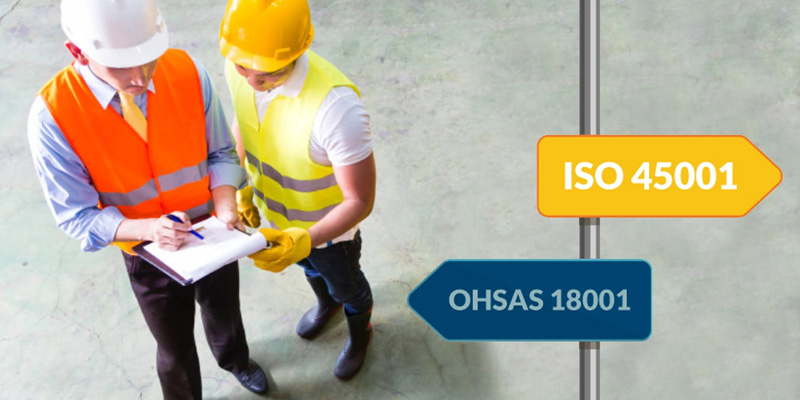
10 Benefits of ISO 45001 for all bussinesses
ISO 45001 is a standard that helps organisations integrate aspects of health ...
Read MoreThere is a considerable burden from occupational injuries and diseases, worldwide, resulting in losses due to early retirement, employee absence and higher premiums on insurance policy. Additionally, the mortality rate for work-related accidents is significant. To address this problem, the International Organization for Standardization (ISO) developed a standard, namely the ISO 45001, which addresses occupational health. In context to Occupational Health and Safety (OHS) management, the ISO 45001 and the Occupational Health and Safety Assessment Series (OHSAS) 18001 are interrelated, since they both aim at providing organisations with a structure to manage their activities safely.
You can get more information about the difference between ISO 45001 and ISO 18001 with the help of ISO Consulting in Australia.

The aim of both the standards is to identify and control the risks to which employees are exposed on a daily basis. Despite targeting occupational safety, there are some significant differences between the two standards. The ISO 45001 takes a proactive approach to risk management that begins with the incorporation of health and safety recommendations in the overall management system of an organisation, thus driving top management to have strong leadership role in the safety and health program.
In contrast, the OHSAS 18001 takes a reactive approach to hazard control by delegating responsibilities to a safety management personnel, instead of integrating responsibilities into the overall management system of an organisation. Understanding the difference between these two standards is important for employees as it allows them to explore organisational possibilities. Main differences between ISO 18001 and ISO 45001 are listed below.

The OHSAS 18001 was published in 1991 by the British Standards Institution. After its creation, this standard was widely used across the globe, thus, playing an important role in improving regulations related to occupational health and safety. In fact, contrary to popular belief, the OHSAS 18001 is not a part of the international standards issued by the ISO, yet it is always considered in the same family due to its similar nature and effect.
The foundation for the ISO 45001 is similar to the management system outlined in other ISO standards including the Quality Management System (QMS) of ISO 9001 and the Environmental Management System (EMS) of ISO 14001. Additionally, the standard has included recommendations from other health and safety standards, such as International Labour Organisation Guidelines, the OHSAS 18001 and various labour standards.
In its heart, the ISO 45001 utilises a simple plan-do-check-act model, that gives organisations a structure for planning the controls that need to be put in place to minimise risk and damage to occupational health. The Annex SL divides the standard structure into chapters and sections. You can get more information by reading the plan-do-check-act ISO 45001 article.

As the ISO 45001 structure is based on Annex SL, it facilitates implementation of an integrated management system that the OHSAS 18001 does not provide. Due to this structural difference, the ISO 45001 aligns with different management system standards and applies a common language to all standards. This conformity underscores the importance of considering the organisation as a whole, helping the organisation understand the direct impact of OHS, beyond the obvious internal impacts.
In the ISO 45001, all clauses are dynamic, making implementation easy and efficient. The ISO 45001 requires the involvement of interested parties including workers, suppliers, third-parties, unions, owners, community and customers. The benefit of increased identification and greater work motivation is better engagement, as these parties are involved in the OHS management processes. Reading the article What is ISO 45001 can provide you with more information.
Additionally, it allows for a greater understanding of the factors that need to be managed within the management system allowing everyone to become an agent of transformation in a new organisational culture that focuses on safety. Moreover, the identification and involvement of all interested parties makes this standard applicable to every type and size of organisation, covering a variety of circumstances including a geographical, cultural and social factors.
The OHSAS 18001 is procedure-based whereas the ISO 45001 is process based. The difference is that process based management systems provide a systematic view, allowing organisations to properly explore how processes are inter-related. In contrast, when procedures are the focus, only a specific activity of the process can be improved at a specific time.
Another significant difference between the OHSAS 18001 and the ISO 45001 is that the former exclusively treats risks, whereas the latter considers both risks and opportunities. By considering both risks and opportunities, there is a greater focus on objectives as drivers for improvement and assessing performance. This is the reason why the OHSAS 18001 is considered reactive as it is applicable only when undesirable incidents occur.
The ISO 45001 is considered to have a proactive approach to risks and hazards as it is implemented before something actually happens and requires greater involvement between the team and managers. In fact, when talking about the ISO 45001, management commitment is central to the standard’s effectiveness and interpretation. The evident shift in the new standard towards managerial ownership allows for the development of safety culture within an organisation that is supported by the engagement of managers with workers and demonstrated through a top-down emphasis. Therefore, instead of just providing oversight for the program, management truly become the safety leaders.
ISO certification gives your organisation a competitive edge. By helping you increase operational efficiency and overall product consistency, your business credibility and authority will soar to new heights.

Copyright © 2024 The ISO Council | Privacy Policy